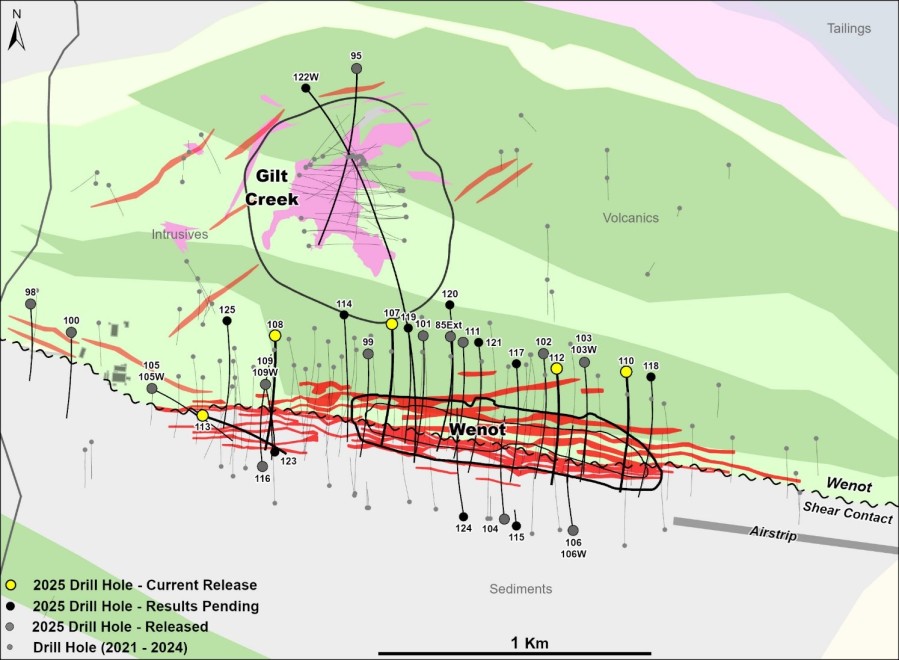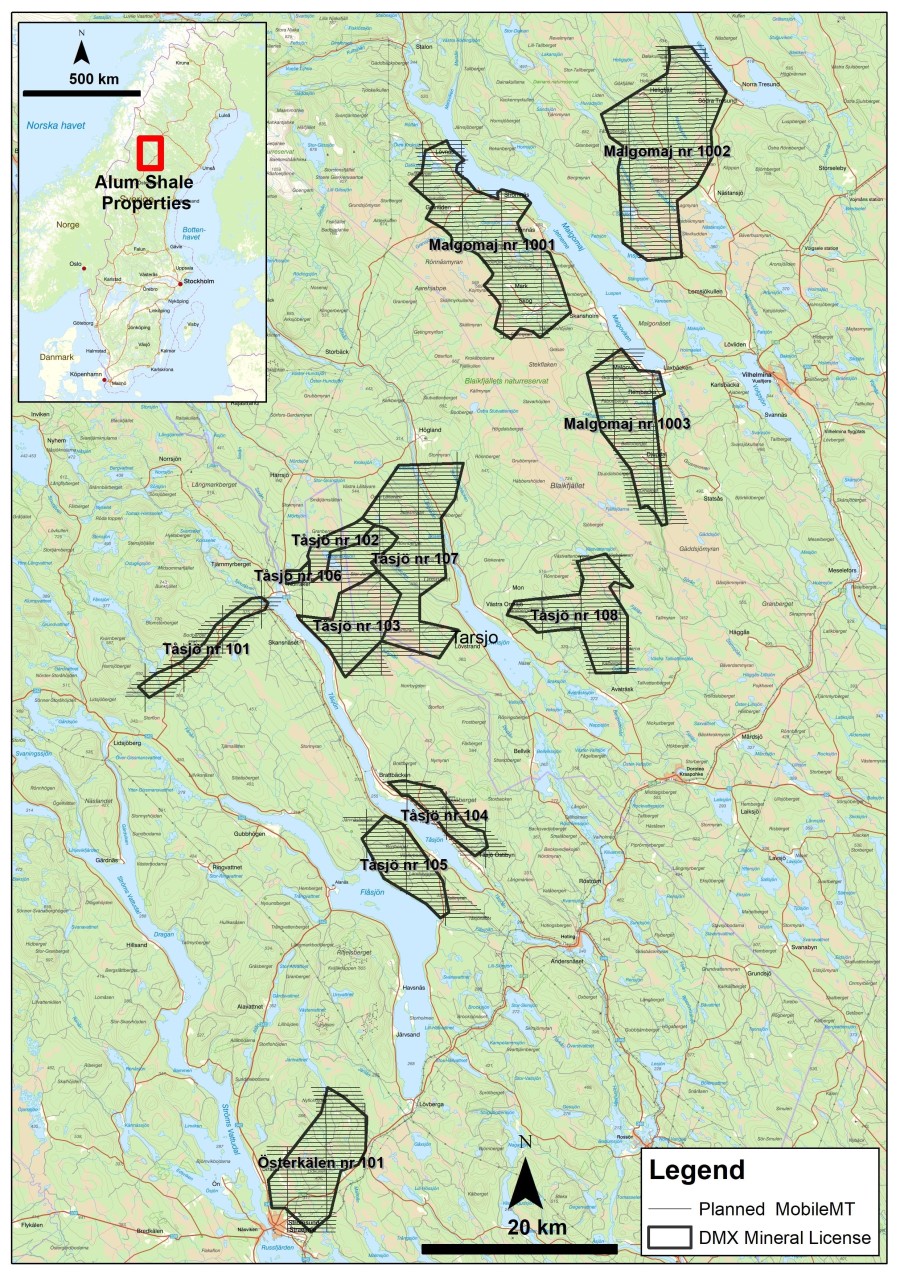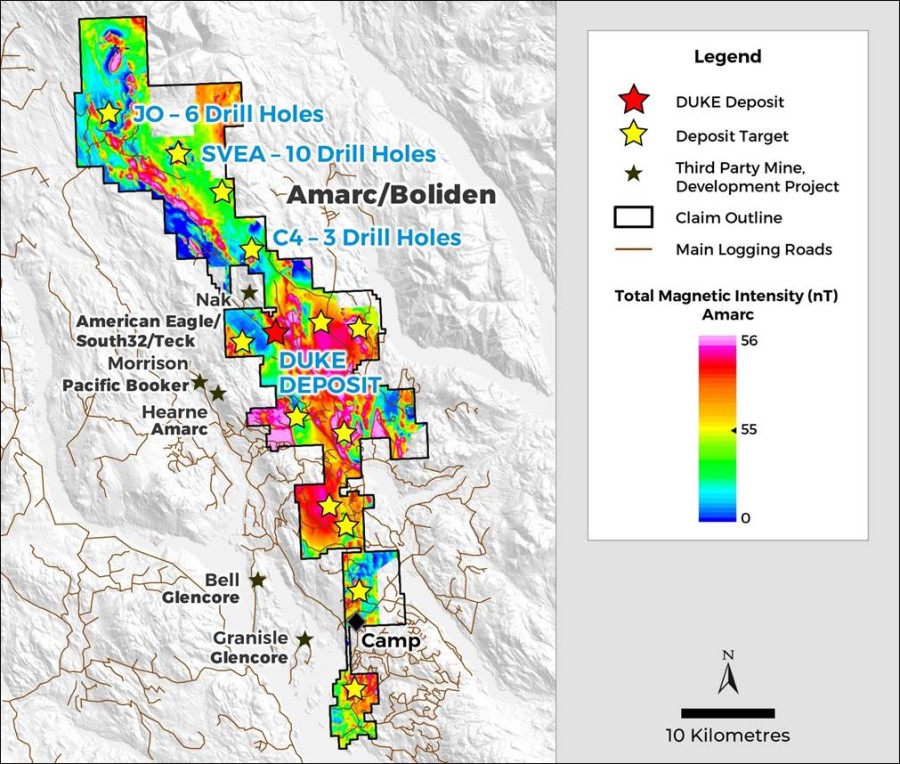Port Moresby, Papua New Guinea--(Newsfile Corp. - July 22, 2025) - Adyton Resources Corporation (TSXV: ADY) ("Adyton" or the "Company") is pleased to report its first preliminary gold only assays from three diamond drill holes and provide an update on its ongoing 2025 drilling activities. This news release is also designed to provide new geological observations on drillholes pending assays at its 100% owned Feni Island project.
HIGHLIGHTS
- Preliminary gold assay results have been returned for the first three (3) drillholes of this drill program at the Feni Island Project (no multi-element assay results or final gold assay results). Results show very consistent and broad gold zones in all three drillholes:
FDD001: 76m @ 1.43g/t Au (from 95m) for 108gxm[1]
FDD002: 144.2m @ 1.18g/t Au (from 45m, EOH) for 170gxm
including: 93m @ 1.58g/t Au (from 45m) for 147gxm
FDD003: 81m @ 1.12g/t Au (from 70m) for 90gxm
- As of July 21, 2025, ten (10) diamond drillholes for 3,332m have been drilled with six (6) drillholes completed, one (1) terminated early, two (2) in-progress and one (1) abandoned. Sawn core samples from drillholes FDD001 through to FDD005 have been dispatched to the laboratory and are either awaiting final laboratory results or in transit.
- Target hole depths are typically 400m, with holes FDD001 and FDD002 achieving 396m and 196m respectfully - FDD002 was terminated prematurely due to operational issues. Holes FDD003 and FDD004 ending at 421.7m and 453.2m, respectively. Hole FDD004 was terminated largely due to operational reasons with end of hole core observations indicating ongoing evidence of vein hosted and disseminated sulphide mineralization. Due to significant visual mineralization observations, FDD005 was drilled to 839m and terminated with visual mineralization still observed at EOH. FDD006 and FDD007 were terminated at 412m and 468m respectively.
- The preliminary assay results for the first three holes confirm that our observations of shallow (below post-mineral tephra) sulphide mineralized hydrothermal breccias are consistently gold bearing.
- Similar, and stronger as well as deeper, visual sulphide mineralized breccias have been observed in remaining drillholes to date, including: FDD004, FDD005, FDD006, and FDD007.
(Cautionary Statement: Observations of mineralization do not necessarily accurately predict true laboratory determined assay mineralization. Analytical assay results are pending and required to confirm the presence and grade of mineralization.)
Tim Crossley, Chief Executive Officer, commented: "These preliminary gold assays are very encouraging and demonstrate consistently greater than 100 gram/metre grade intercepts at relatively shallow depths. Subsequent to these holes being drilled we have tested for deeper mineralized extensions outside of the existing block model and we have had success with strong visual observed mineralisation to end of the holes. In particular, hole FDD005 was drilled to 839m and showed visual mineralisation from 45m through to end of hole, for a 794m mineralized interval. This hole in particular has generated a lot of excitement with our geology team as we await with interest for the assays to be reported."
Dr Chris Bowden COO and Chief Geologist, commented: "We are encouraged by what we are seeing in the drill core from this round of drilling at the Feni Island project. Initial assay results (preliminary gold only) for the first three drillholes confirm the geological model for the shallow, gold-bearing hydrothermal breccias encountered just below the base of the post-mineral tephra cover. These initial assay results give us confidence in the additional drillholes that also show visual observations of strong sulphide mineralisation within similar breccias, plus the upside of the deeper porphyry-style mineralisation (still pending assays)."
Significant Intercepts and Geology
Table 1 shows the Significant Intercepts received to date based on preliminary gold assays for the first three drillholes. Figures 2 and 3 show examples of gold mineralization based on assays. Figures 4 to 8 show examples of visual mineralization (pending assays). Table 2 provides a summary of the status of the Feni drill program.
Table 1: Significant Intercepts from the Feni Project (preliminary gold assays to date)
| Hole ID | From (m) |
Interval (m) |
Gold (Au g/t) |
Copper (Cu %) |
Gold Equiv.[2] (Au.eq g/t) |
Au.eq (gxm) Gram Metre |
| FDD001 | 95 | 76 | 1.43 | pending | pending | 108 |
| FDD002 | 45 | 144.2 | 1.18 | pending | pending | 170 |
| inc. | 45 | 93 | 1.58 | pending | pending | 147 |
| FDD003 | 70 | 81 | 1.12 | pending | pending | 90 |
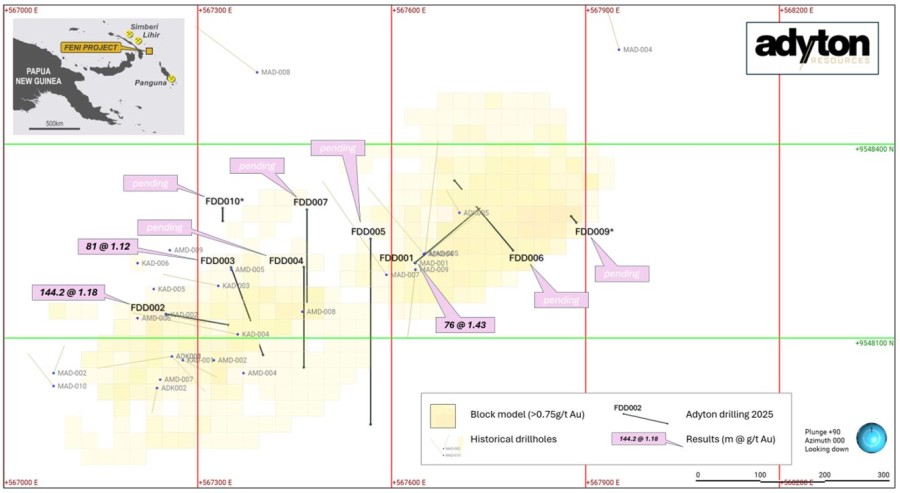 Figure 1: Plan view of the current drill program and targets within the existing Kabang to Matangkaka mineralized corridor.
Figure 1: Plan view of the current drill program and targets within the existing Kabang to Matangkaka mineralized corridor.
Core photos of visual mineralization (assays pending) including examples from: FDD001 (Figure 2), FDD002 (Figure 3), FDD004 (Figure 4), FDD005 (Figures 5 & 6), FDD006 (Figure 7), and FDD007 (Figure 8).
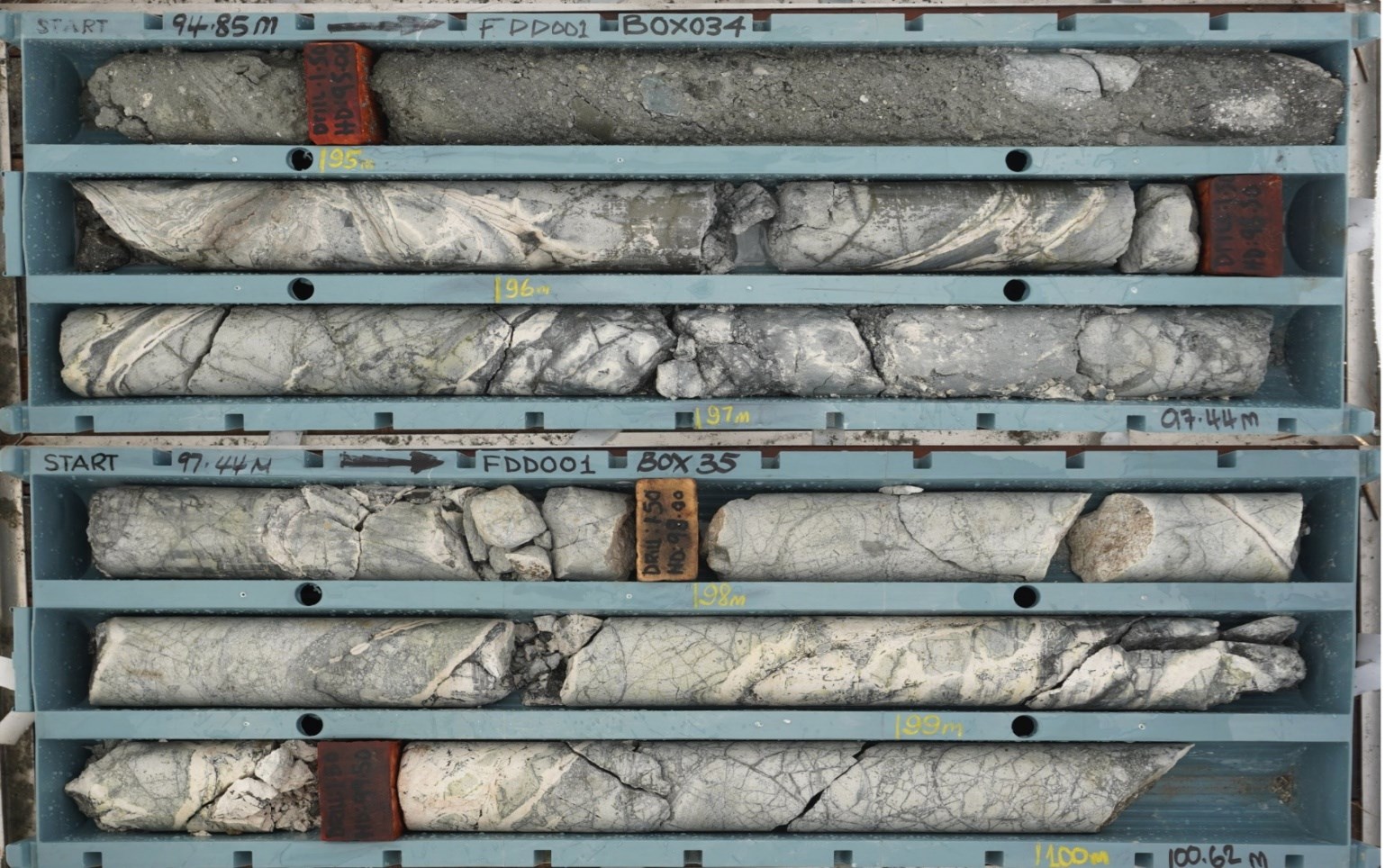 Figure 2: FDD001 Box 34-35. Tephra (top run) into sulphide mineralized hydrothermal breccia. Within the 76m @ 1.43g/t Au, the interval from 97m to 102m graded 5m @ 3.31g/t Au.
Figure 2: FDD001 Box 34-35. Tephra (top run) into sulphide mineralized hydrothermal breccia. Within the 76m @ 1.43g/t Au, the interval from 97m to 102m graded 5m @ 3.31g/t Au.
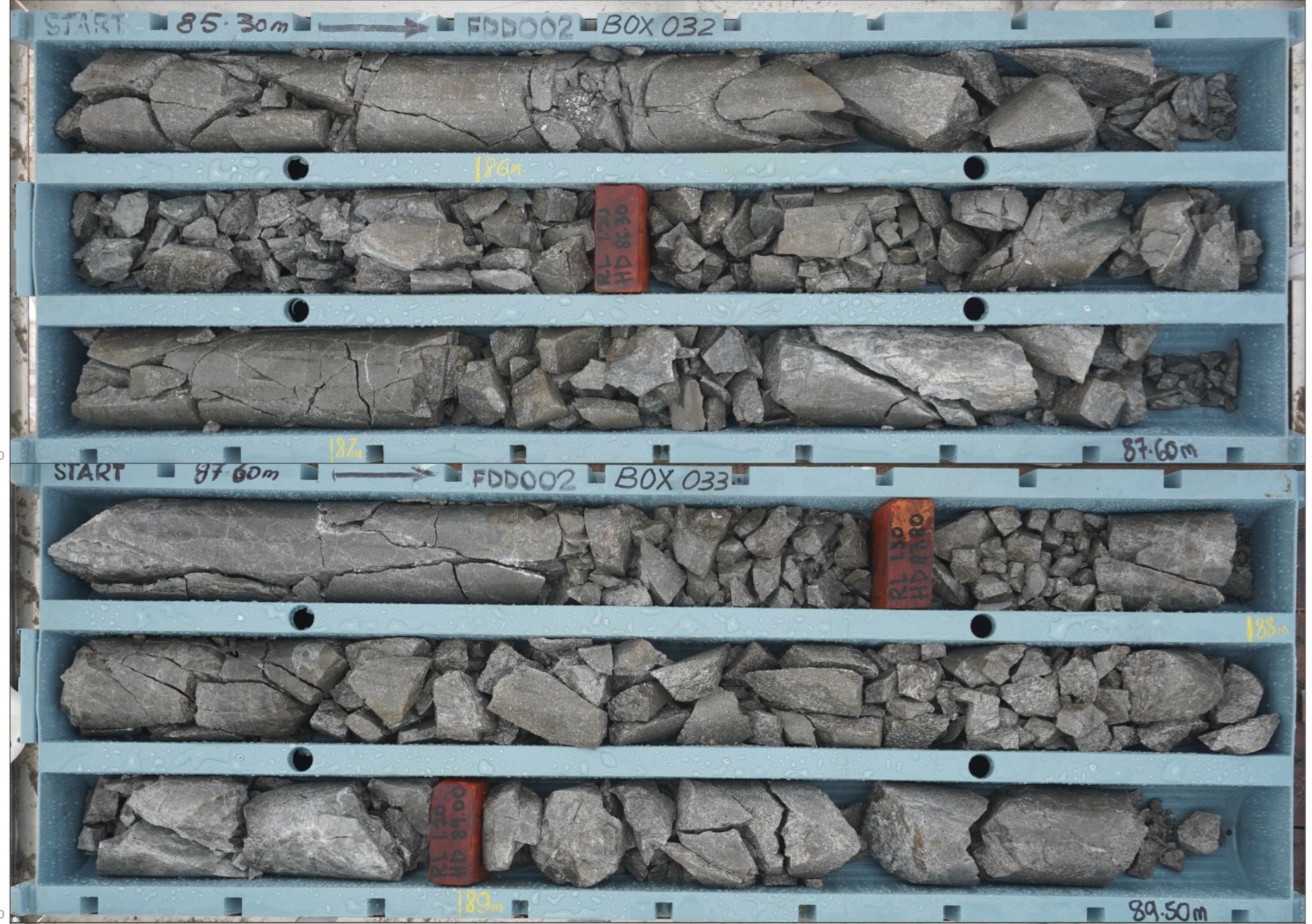 Figure 3: FDD002 Box 32-33. Sulphide mineralized breccia. Within the 144.2m @ 1.18g/t Au (to EOH), the interval 86m to 90m graded 4m @ 3.15g/t Au.
Figure 3: FDD002 Box 32-33. Sulphide mineralized breccia. Within the 144.2m @ 1.18g/t Au (to EOH), the interval 86m to 90m graded 4m @ 3.15g/t Au.
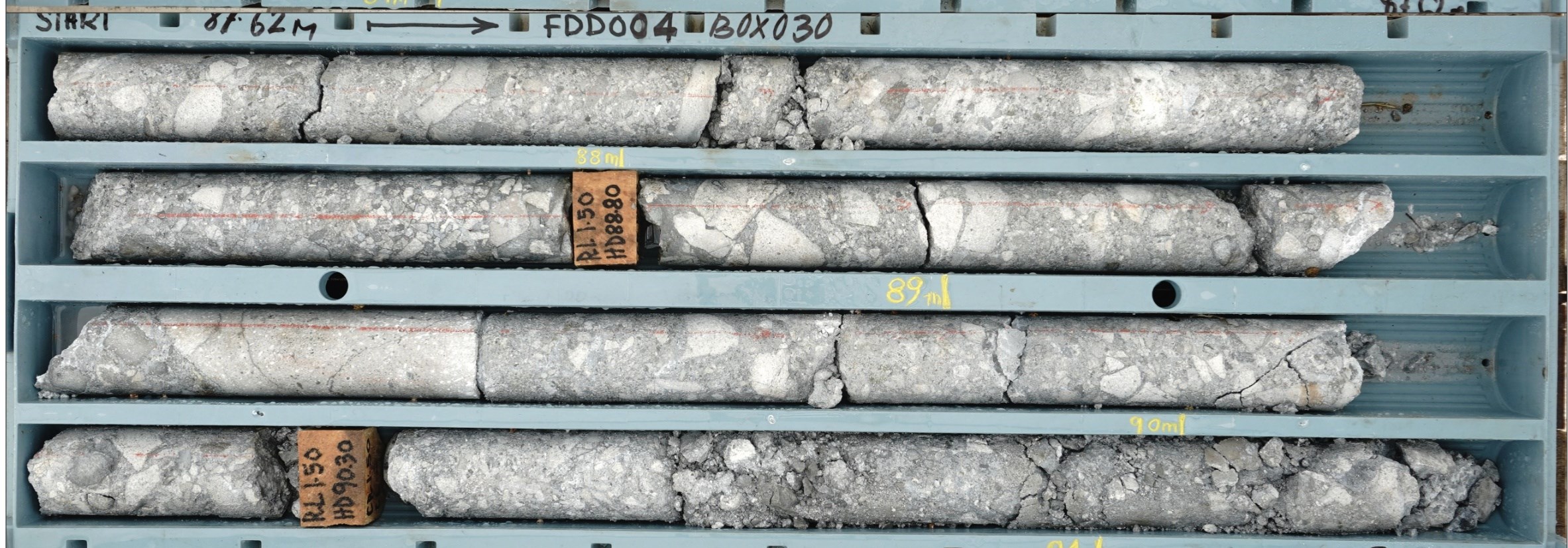 Figure 4: FDD004 from 87.62m to 91.2m. Sulphide (pyrite 5%) mineralized breccia (assays pending).
Figure 4: FDD004 from 87.62m to 91.2m. Sulphide (pyrite 5%) mineralized breccia (assays pending).
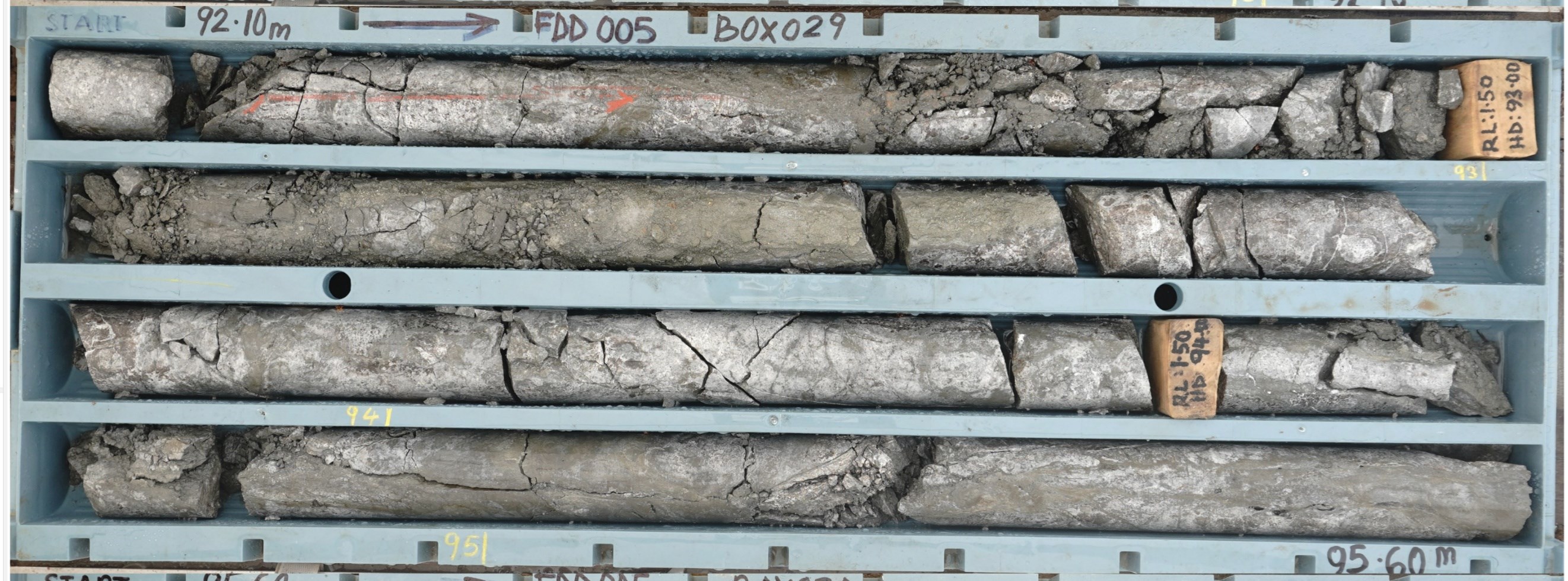 Figure 5: FDD005 from 92.10m to 95.60m. Semi-massive sulphide (5-10% pyrite-arsenopyrite-chalcopyrite) (assays pending).
Figure 5: FDD005 from 92.10m to 95.60m. Semi-massive sulphide (5-10% pyrite-arsenopyrite-chalcopyrite) (assays pending).
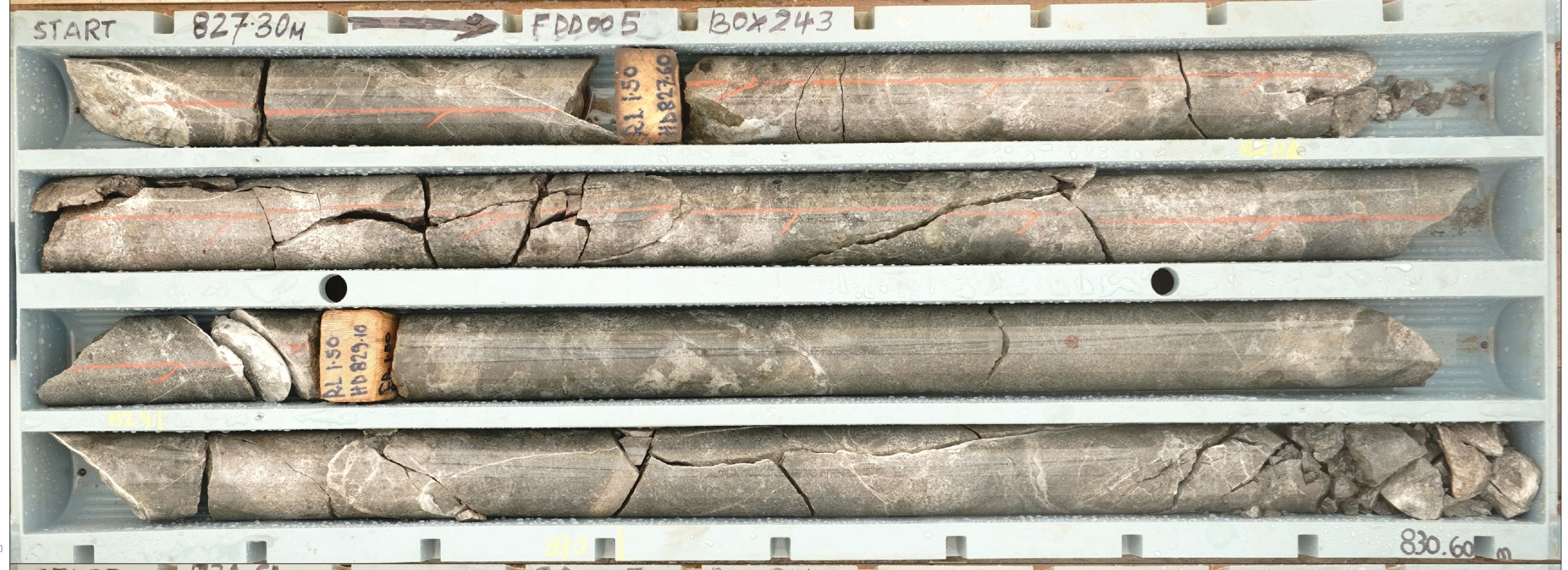 Figure 6: FDD005 Box 243 From 827.30m to 830.60m: monzodiorite with pervasive potassic (biotite+/-k-feldspar) alteration, quartz+/-magnetite+/-pyrite/chalcopyrite veining and disseminated pyrite (3%) and chalcopyrite (1%) (assays pending).
Figure 6: FDD005 Box 243 From 827.30m to 830.60m: monzodiorite with pervasive potassic (biotite+/-k-feldspar) alteration, quartz+/-magnetite+/-pyrite/chalcopyrite veining and disseminated pyrite (3%) and chalcopyrite (1%) (assays pending).
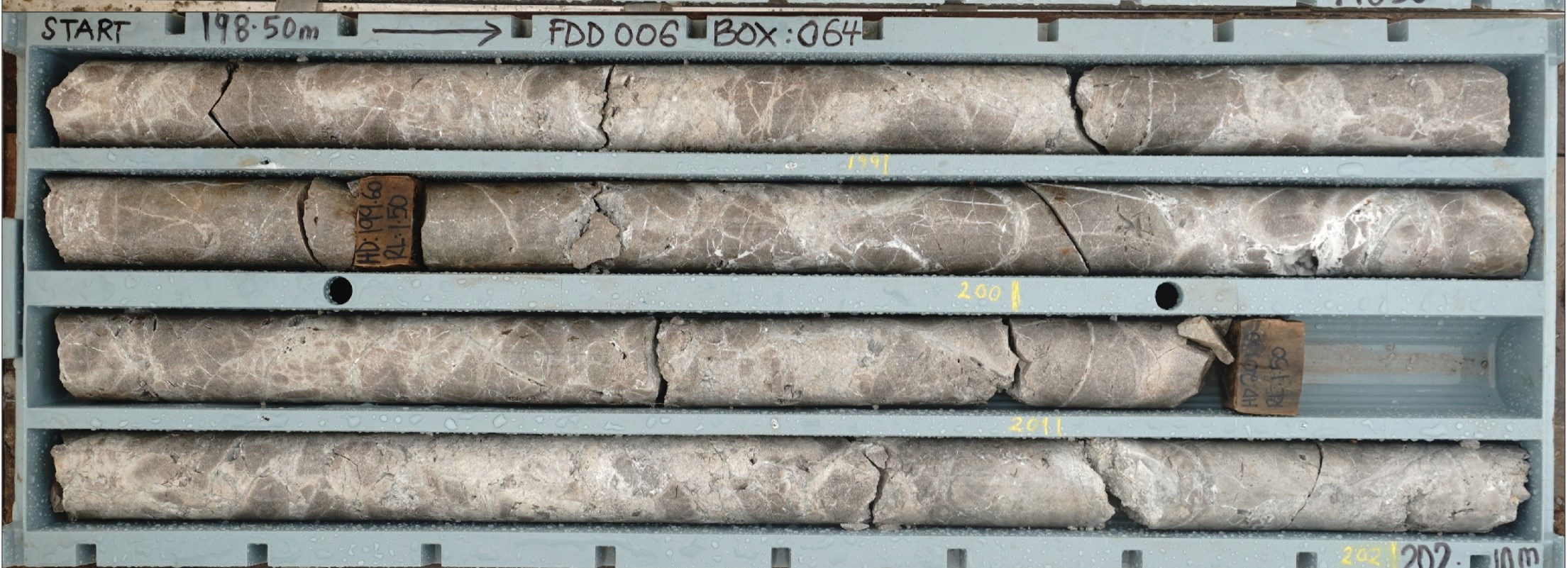 Figure 7: FDD006 from 198.5m to 202.10m. Potassic altered intrusive with stockwork qz-anhydrite veining with pervasively disseminated fine sulphides (pyrite 3%) (assays pending).
Figure 7: FDD006 from 198.5m to 202.10m. Potassic altered intrusive with stockwork qz-anhydrite veining with pervasively disseminated fine sulphides (pyrite 3%) (assays pending).
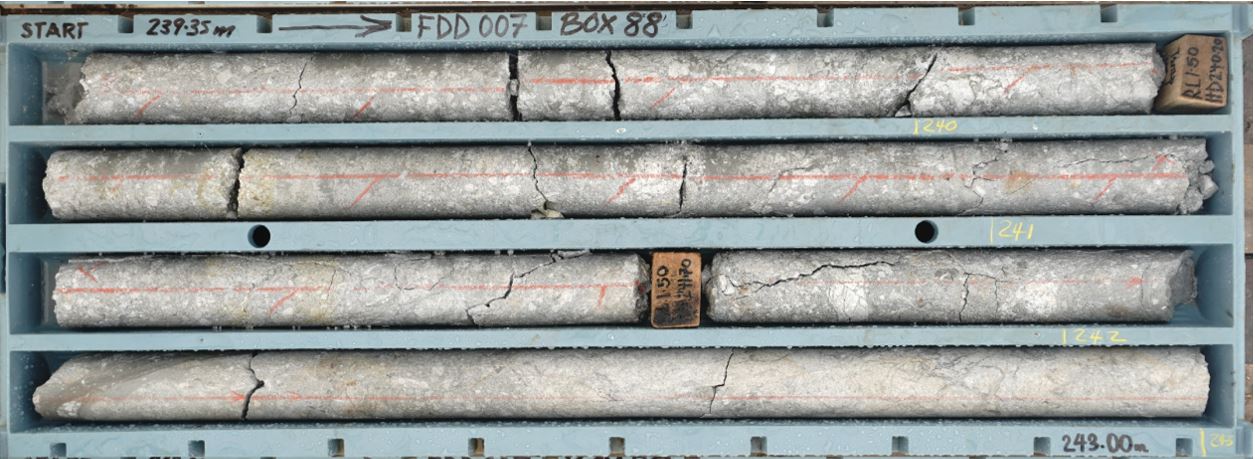 Figure 8: FDD007 zone proximal to 240m. Strongly sulphide-silica-clay altered and mineralised breccia (ca. 5-10% py-asp) (assays pending).
Figure 8: FDD007 zone proximal to 240m. Strongly sulphide-silica-clay altered and mineralised breccia (ca. 5-10% py-asp) (assays pending).
Visual Results - Geological Observations from Core Logging
FDD004 Drillhole
FDD004 tested the Gap between the Kabang and Matangkaka mineralized zones that include the MRE. From the base of tephra to end of hole (EOH), FDD004 intersected variably mineralized breccias and intrusive units.
Highlights include:
-
Hydrothermal breccias showing strong sulphide mineralization from base of tephra (45m) to 111m.
-
Intrusives to intrusive breccias showing disseminated and veined mineralization from 111m to end of hole (EOH). These intrusives showed a variety of mineralization styles, from shallow to depth showing: fine-grained disseminated and fracture filled sulphide veinlets, weak potassic alteration and disseminated and fracture filled sulphides, silica flooded with fractures and veinlets filled with chalcopyrite+pyrite, anhydrite-pyrite-chalcopyrite+-bornite vein mineralization, and porphyry style alteration assemblage of secondary biotite-magnetite-actinolite-chalcopyrite with stockwork pyrite-chalcopyrite-magnetite veining.
FDD005 Drillhole
FDD005 was designed to test the Gap between Kabang and Matangkaka zones and east of hole FDD004. FDD005 was drilled to a depth of 839.60m. This drillhole encountered a sequence of hydrothermal breccias (HBX), diorites, microdiorite, monzodiorite, and andesitic dykes, exhibiting silicic, sulphide, clay and potassic alteration. Sulphide mineralization is widespread, ranging from disseminated to semi-massive pyrite and chalcopyrite, with key mineralized zones developed from surface to over 800m depth downhole (-70 dip and EOH to 839m equals 788m vertical depth).
Highlights include:
-
Hydrothermal breccias with strong sulphide mineralization from base of tephra to depth. Variably manifesting as polymict to monomict breccias (predominantly brecciated intrusive rocks).
-
Semi-massive sulphides (up to 10%) in brecciated zones, an example at 89.7 to 96.0m.
-
Stockwork veining and fine disseminated sulphides over broad intervals from 120m to 347.6m and 450m to 616.1m.
-
Deep, continuous veining and disseminated mineralization within altered monzodiorite from 743m to 829.1m (EOH), with 2-4% sulphide content.
FDD006 Drillhole
FDD006 is testing the northeast extension of Matangkaka zone and is outside any previous drilling. FDD006 was drilled to a depth of 412.6m. The upper 69 metres intersected tephra cover. From 69m to end of hole, intersected extensive hydrothermal breccias and mineralized intrusives.
Highlights include:
-
69m to 207m: hydrothermal breccias with strong sulphide mineralization from base of tephra to depth. Variably manifesting as polymict to monomict breccias (predominantly brecciated intrusive rocks).
-
207m to 315m: fine- to medium-grained intrusive rocks and brecciated intervals showing pervasive chlorite-silica-pyrite alteration, with 2-5% disseminated pyrite and up to 1% chalcopyrite.
-
315.2m to 316.6m: vein-hosted quartz-magnetite-pyrite-chalcopyrite, with chalcopyrite up to 1%.
-
320.2m to 360.1m: strongly brecciated intrusive rocks with sulphide-rich matrix infill.
-
360.1m to 412.6m: Polymictic hydrothermal breccia with 2-4% sulphides, including clasts exceeding 5% sulphide content.
FDD007 Drillhole
FDD007 is testing the lateral extent of the gold bearing hydrothermal breccias in a north to northwesterly direction, located north of FDD005. FDD007 was drilled to a depth of 468.20m. The hole encountered extensive hydrothermal breccias and a range of intrusive units including monzodiorite, quartz monzodiorite, and diorite. Widespread disseminated and fracture-hosted sulphides (primarily pyrite, chalcopyrite, and arsenopyrite) were observed throughout, with total sulphide contents locally reaching 6-10%.
Highlights include:
-
63.2m to 100.0m: hydrothermal breccia with strong pyrite and chalcopyrite mineralization.
-
100.0m to 133.7m: silicified zones and fractured monzodiorite with up to 6% total sulphides.
-
133.7m to 175.2m: intensely fractured monzodiorite with pyrite, chalcopyrite, and arsenopyrite up to 6%.
-
221.0m to 243.2m: strongly mineralized hydrothermal breccia zone with 5-10% sulphides and intense silica-clay alteration-potential high-grade gold zone.
-
243.2m to 350.7m: fractured monzodiorite and diorite with consistent sulphide content (3-6%) and strong quartz-anhydrite veining.
-
370.1m to 427.7m: pervasively altered diorite with increasing sulphide intensity, potassic and clay overprinting, and stockwork vein development.
-
427.7m to 468.2m: diorite with disseminated sulphides and notable potassic alteration and sporadic mineralized quartz-chlorite veinlets.
Table 2: Feni Drill Hole Details (WGS 84 Zone 56S UTM coordinates)
| Hole ID | Easting | Northing | RL | DIP | AZI | Depth (m) | Status |
| FDD001 | 567,648 | 9,548,228 | 156 | -60 | 50 | 396.0 | Completed |
| FDD002 | 567,245 | 9,548,135 | 91 | -60 | 100 | 195.4 | Terminated prematurely 1 |
| FDD003 | 567,348 | 9,548,221 | 105 | -70 | 160 | 421.7 | Completed |
| FDD004 | 567,469 | 9,548,209 | 126 | -70 | 180 | 453.2 | Completed |
| FDD005 | 567,571 | 9,548,247 | 136 | -70 | 180 | 839.6 | Completed |
| FDD006 | 567,782 | 9,548,230 | 184 | -70 | 320 | 412.6 | Completed |
| FDD007 | 567,469 | 9,548,305 | 111 | -70 | 174 | 468.2 | Completed |
| FDD008 | 567,886 | 9,548,273 | 193 | -70 | 314 | 67.9 | Abandoned 1 |
| FDD009 | 567,895 | 9,548,274 | 193 | -70 | 314 | 37.4 | In-progress |
| FDD010 | 567,342 | 9,548,282 | 108 | -70 | 174 | 40.0 | In-progress |
1 FDD008 were abandoned at a shallow depth while still in post mineral cover due to operational issues. FDD002 was terminated prematurely due to ground conditions while still in observed visual mineralisation.
Feni Island on-trend location
The Adyton projects are located in PNG on easily accessible island locations. Feni Island is part of the Tabar to Feni Island chain to the Northwest that hosts the operating gold mines of Simbiri and Lihir while Feni hosts a foundation resource of inferred 1.45mozAu. To the southeast of Feni on Bougainville Island lies the giant Panguna deposit.
For further information please contact:
Tim Crossley, Chief Executive Officer
E‐mail: This email address is being protected from spambots. You need JavaScript enabled to view it.
Phone: +61 7 3854 2389
Phone: +1 778 549 6768
Neither the TSX Venture Exchange nor its Regulation Services Provider (as that term is defined in the policies of the TSX Venture Exchange) accepts responsibility for the adequacy or accuracy of this press release.
ABOUT ADYTON RESOURCES CORPORATION
Adyton Resources Corporation is focused on the development of gold and copper resources in world class mineral jurisdictions. It currently has a portfolio of highly prospective mineral exploration projects in Papua New Guinea on which it is exploring to expand its identified gold Inferred and Indicated Mineral Resources and expand on its recent significant copper drill intercepts on the 100% owned Feni Island project. The Company's mineral exploration projects are located on the Pacific Ring of Fire on easy to access island locations which hosts several globally significant copper and gold deposits including the Lihir gold mine and Panguna copper/gold mine on Bougainville Island, both neighboring projects to the Company's Feni Island project.
Adyton has a total Mineral Resource Estimate inventory within its PNG portfolio of projects comprising indicated resources of 173,000 ounces gold and inferred resources of 2,000,000 ounces gold.
The Feni Island Project currently has a mineral resource prepared in accordance with NI 43-101 dated October 14, 2021, which has outlined an initial inferred mineral resource of 60.4 million tonnes at an average grade of 0.75 g/t Au, for contained gold of 1,460,000 ounces, assuming a cut-off grade of 0.5 g/t Au. See the NI 43-101 technical report entitled "NI 43-101 Technical Report on the Feni Gold-Copper Property, New Ireland Province, Papua New Guinea prepared for Adyton Resources by Mark Berry (MAIG), Simon Tear (MIGI PGeo), Matthew White (MAIG) and Andy Thomas (MAIG), each an independent mining consultant and "qualified person" as defined in NI 43-101,available under Adyton's profile on SEDAR+ at www.sedarplus.ca. Mineral resources are not mineral reserves and have not demonstrated economic viability.
The Fergusson Island Project currently has a mineral resource prepared in accordance with NI 43-101 dated October 14, 2021, which outlined an indicated mineral resource of 4.0 million tonnes at an average grade of 1.33 g/t Au for contained gold of 173,000 ounces and an inferred mineral resource of 16.3 million tonnes at an average grade of 1.02 g/t Au for contained gold of 540,000 ounces. See the technical report entitled "NI 43-101 Technical Report on the Fergusson Gold Property, Milne Bay Province, Papua New Guinea" prepared for Adyton Resources by Mark Berry (MAIG), Simon Tear (MIGI PGeo), Matthew White (MAIG) and Andy Thomas (MAIG), each an independent mining consultant and "qualified person" as defined in NI 43-101,available under the Company's profile on SEDAR+ at www.sedarplus.ca. Mineral resources are not mineral reserves and have not demonstrated economic viability.
For more information about Adyton and its projects, visit www.adytonresources.com.
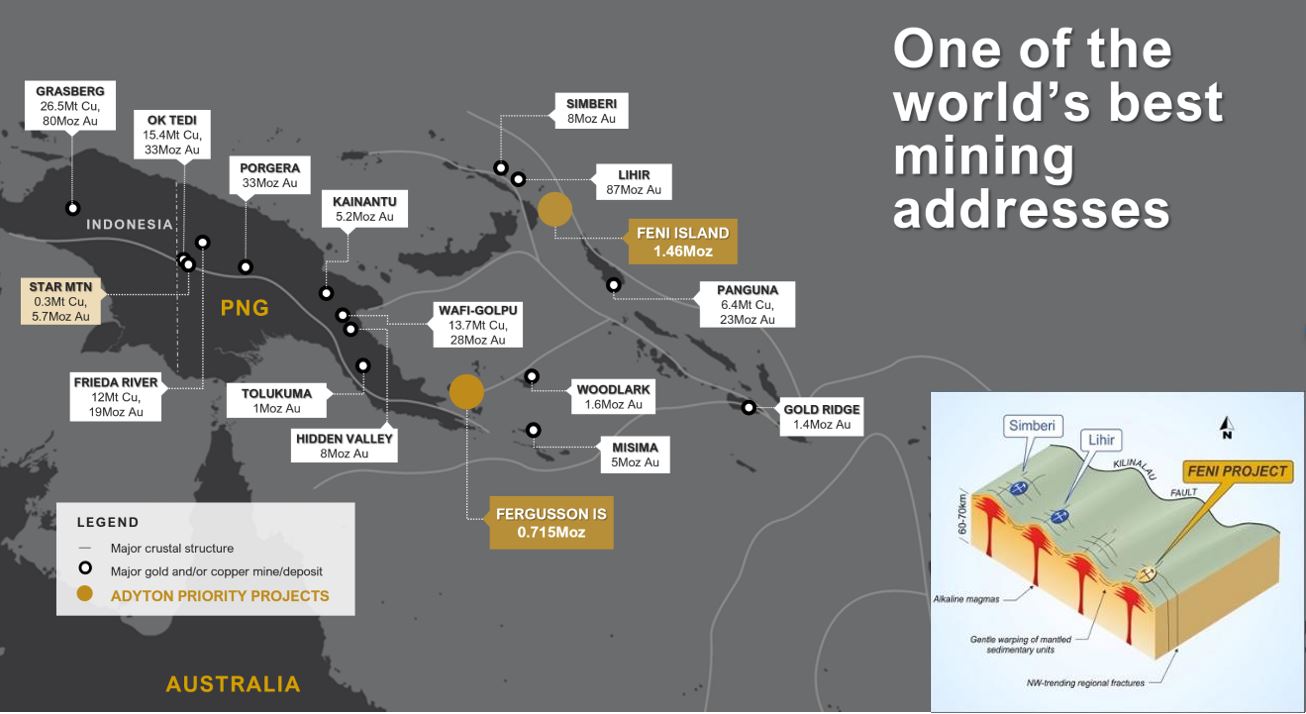
Qualified Person
The scientific and technical information contained in this press release has been prepared, reviewed, and approved by Dr Chris Bowden, PhD, GCMEE, FAusIMM(CP), FSEG, the Chief Operating Officer and Chief Geologist of Adyton, who is a "Qualified Person" as defined by National Instrument 43‐101 ‐ Standards of Disclosure for Mineral Projects.
Forward-looking statements
This press release includes "forward‐looking statements," including forecasts, estimates, expectations, and objectives for future operations that are subject to several assumptions, risks, and uncertainties, many of which are beyond the control of Adyton. Forward‐ looking statements and information can generally be identified by the use of forward‐looking terminology such as "may", "will", "should", "expect", "intend", "estimate", "anticipate", "believe", "continue", "plans" or similar terminology. Forward-looking statements in this news release include plans pertaining to the drill program, the intention to prepare additional technical studies, the timing of the drill program, uses of the recent drone survey data, the timing of updating key findings, the preparation of resource estimates, and the deeper exploration of high-grade gold and copper feeder systems . The forward‐looking information contained herein is provided for the purpose of assisting readers in understanding management's current expectations and plans relating to the future. Readers are cautioned that such information may not be appropriate for other purposes.
Forward‐looking information are based on management of the parties' reasonable assumptions, estimates, expectations, analyses, and opinions, which are based on such management's experience and perception of trends, current conditions and expected developments, the receipt of any necessary permits, licenses and regulatory approvals in connection with the future development of the projects in a timely manner; the availability of financing on suitable terms for the development; construction and continued operation of the Fergusson Island Project and the Feni Island Project; the ability to effectively complete the drilling program; and Adyton's ability to comply with all applicable regulations and laws, including environmental, health and safety laws.
Investors are cautioned that forward-looking statements are not based on historical facts but instead reflect Adyton's management's expectations, estimates or projections concerning future results or events based on the opinions, assumptions and estimates of managements considered reasonable at the date the statements are made. Although Adyton believes that the expectations reflected in such forward-looking statements are reasonable, such information involves risks and uncertainties, and under reliance should not be placed on such information, as unknown or unpredictable factors could have material adverse effects on future results, performance or achievements expressed or implied by Adyton. Among the key risk factors that could cause actual results to differ materially from those projected in the forward-looking statements are the following: impacts arising from the global disruption, changes in general macroeconomic conditions; reliance on key personnel; reliance on Zenex Drilling; changes in securities markets; changes in the price of gold or certain other commodities; change in national and local government, legislation, taxation, controls, regulations and political or economic developments; risks and hazards associated with the business of mineral exploration, development and mining (including environmental hazards, industrial accidents, unusual or unexpected formations pressures, cave‐ins and flooding); discrepancies between actual and estimated metallurgical recoveries; inability to obtain adequate insurance to cover risks and hazards; the presence of laws and regulations that may impose restrictions on mining; employee relations; relationships with and claims by local communities and indigenous populations; availability of and changes in the costs associated with mining inputs and labour; the speculative nature of mineral exploration and development (including the risks of obtaining necessary licenses, permits and approvals from government authorities); and title to properties. Investors are cautioned that any such statements are not guarantees of future performance and that actual results or developments may differ materially from those projected in the forward‐looking statements. Such forward‐looking information represents management's best judgment based on information currently available. No forward‐looking statement can be guaranteed, and actual future results may vary materially. Readers are cautioned not to place undue reliance on forward-looking statements or information. Adyton Resources Corporation undertakes no obligation to update forward‐looking information except as required by applicable law.
[1] 'gxm' is the sum product of gold grade and widths. This is a common industry metric for reviewing gold results.
[2] Gold equivalent calculated as follows: Au.eq = (Au g/t + 1.12(Cu %))
NOT FOR DISSEMINATION IN THE UNITED STATES OR FOR DISTRIBUTION TO U.S. NEWSWIRE SERVICES.


